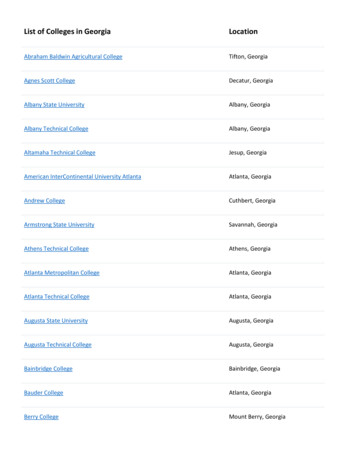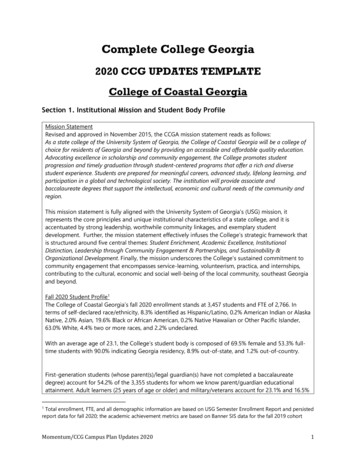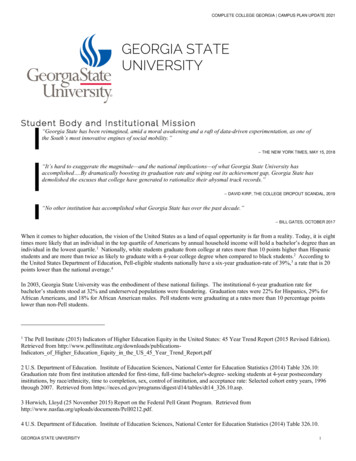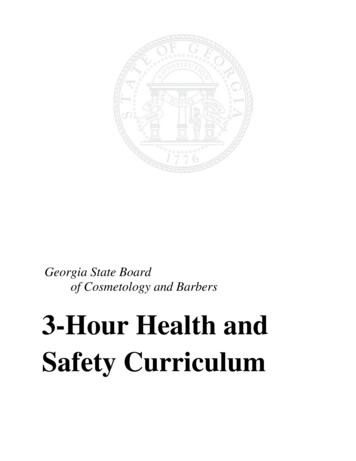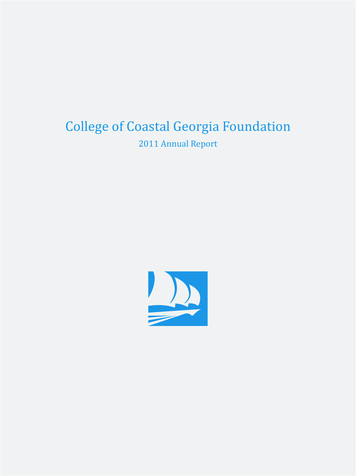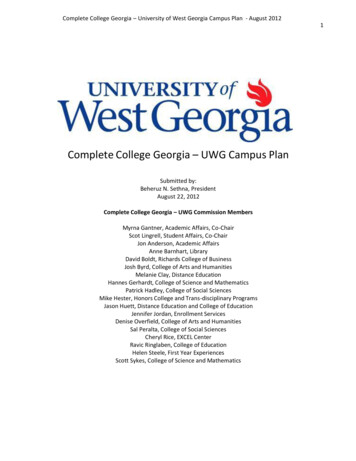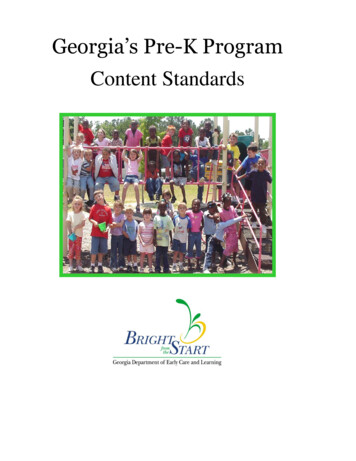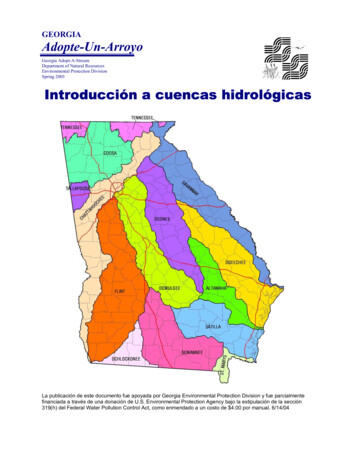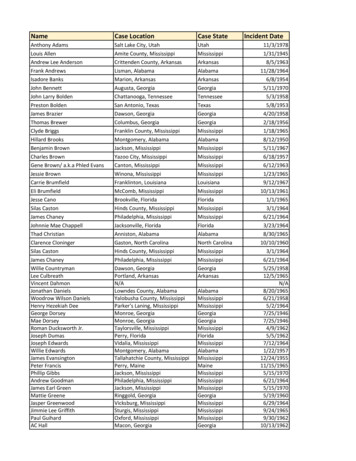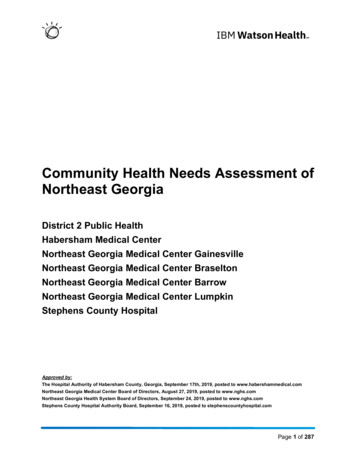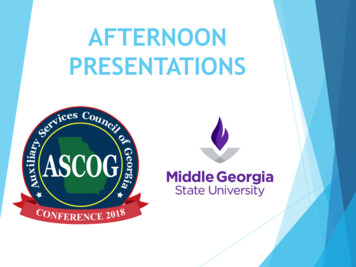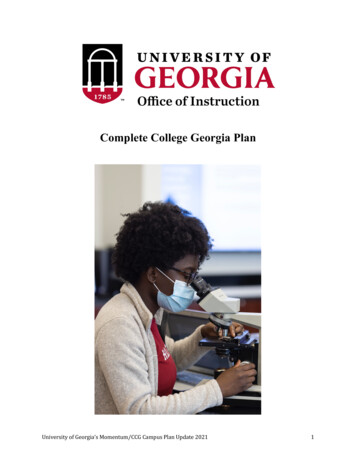
Transcription
Complete College Georgia PlanUniversity of Georgia’s Momentum/CCG Campus Plan Update 20211
Complete College Georgia2021 UPDATE for The University of GeorgiaSection 1. Institutional Mission and Student Body ProfileThe University of Georgia is the birthplace of public higher education in the U.S. It is the state’soldest, most comprehensive, and most diversified institution of higher education—an institutionthat values its role as a land- and sea-grant institution and honors its commitments andresponsibilities to the entire state of Georgia. With more than 10,000 faculty and staff membersand over 39,000 students (undergraduate, graduate, and professional, enrolled in 18 schools orcolleges). It offers 24 Baccalaureate degrees in more than 140 areas and, pre-COVID, hostedmore than 250 study abroad, exchange programs, and field school opportunities. UGA iscommitted to providing a superior teaching and learning environment, to serving a diversestudent body, and to promoting student success.There is no single undergraduate student profile at the University of Georgia. Rather theinstitution welcomes diverse students with widely varying backgrounds, interests, experiences,and challenges. The typical UGA undergraduate is of traditional age ( 24 years), enters as afirst-year student, lives on campus for the first year, and is seeking a first undergraduate degree.In addition, UGA is admitting more transfer students each semester. In Fall 2020, the totalundergraduate population numbered 29,765 students, the vast majority of whom hailed from thestate of Georgia (88% vs. 11% out-of-state and 1% international). The majority of undergraduatestudents (94%) were enrolled full time; 58% were female; 30% (self-reported) were ofracial/ethnic minority status; 24% were Pell-eligible; 6% were first-generation; and 2% wereover the age of 24.UGA is committed to recruiting, retaining, and supporting the academic success ofunderrepresented, first-generation, rural, and other traditionally underserved students and toincreasing the affordability of a UGA degree. UGA launched the Georgia CommitmentScholarship campaign to put a UGA education within the financial reach of more residents of thestate. The GCS program is a need-based scholarship program that is open to first-yearundergraduate students. The scholarship which is renewable for up to four years (8 semesters)comes with a variety of programs and resources to support student success. The total number ofGCS recipients has steadily increased from 94 in AY 2017-18 to 569 in 2020-21. For the 20202021 academic year, the Office of Student Financial Aid disbursed a total of 382,918,038 offederal, state, institutional, and other/external programs to 29,243 unique undergraduate students(19% of whom received a Federal Pell Grant with over 200 students self-identifying asindependent, i.e., former foster youth, wards of the court, orphans, homeless or with legalguardians). To increase affordability, UGA once again eliminated all lab and course material feesand continues to consider new ways to remove financial barriers for our students.UGA is among institutions with the highest retention and graduation rates nationwide (seeAppendix A, Tables 1-3); they surpass those of our comparator peers and exceed or are on parwith our aspirational peers. The University has an exceptional first-year retention rate of 94.97%for the 2020 cohort which is up from the 94.4% for the 2019 cohort but still below the 95.5%rate for the 2018 cohort—a dip that we attribute to the continuing disruptions caused by COVID19. The six-year completion rate for the 2015 entering cohort increased significantly to 87.84%(from 87.2% for the 2014 cohort), and the four-year completion rate for the 2017 entering cohortUniversity of Georgia’s Momentum/CCG Campus Plan Update 20212
increased to 72.1% (up from 71.4% last year). The average time to degree has steadily declinedfrom 4.07 years (students who graduated in 2012) to 3.93 (students who graduated in 2021, seeAppendix A, Table 3).These retention and completion rates are stellar, but UGA seeks to do better. We recently pulleddata on students who did not complete their degree and discovered that most were not students inacademic distress. Rather, there were two distinct sets of high-achieving students who weretransferring out of UGA: one set transferred to Georgia Tech after their first year, and the othertransferred after two years to schools in the system that offered a nursing degree (which UGAdoes not offer). This led us to look more closely at students who did not complete their degreeand did not fall into these two groups. There we found students who were having academicdifficulties, going on probation and dismissal, and not completing. To serve these students, wecreated the “Connect and Complete Persistence Framework,” a holistic, research-based, andproactive set of interventions to impact academic performance, mindset, and well-being and toequip students with the resources that we anticipate will enable them to complete their degree.The hallmarks of the framework are the Early Academic Alert which is designed to catchstudents before their situation becomes grave, the creation of a Degree Completion Team foreach of these students, and an intense online module that students will engage while they are onacademic dismissal so that they might return to campus better equipped to succeed. Connect andComplete will officially launch in Fall 2022.Among public universities, the University of Georgia is one of the nation’s top producers ofRhodes Scholars (26). UGA is also home to hundreds of major scholarship winners, including: 2Churchill Scholars, 2 Beinecke Scholars, 8 Gates Cambridge Scholars, 7 Marshall Scholars, 62Goldwater Scholars, 21 Truman Scholars, 24 Udall Scholars, 56 Boren Scholars, 6 SchwarzmanScholars, 3 Mitchell Scholars and 143 Fulbright Student Scholars.UGA’s challenging learning environment and innovative programs continue to garner nationalattention and recognition. UGA boasts one of the top 10 Honors programs in the U.S., anachievement which culminated this year in elevating the Honors Program into the Jere W.Morehead Honors College. In addition, U.S. News & World Report’s “Best Colleges” edition forthis year ranked UGA 16th among public universities; Open Doors ranked it #6 in Study Abroad;Niche ranked it as the #11 Top Public Universities in America. The INSIGHT Into DiversityHigher Education Excellence in Diversity Award recognizes colleges and universities thatdemonstrate an outstanding commitment to diversity and inclusion. UGA has earned thisnational honor every year since 2014.UGA’s comprehensive degree programs, in concert with its innovative learning environment,demonstrate that UGA—thanks to its faculty, staff, students, alumni, and friends—is creatingleaders who are shaping the future of our state, nation, and world.Section 2: Improvement PracticesUGA recruits and enrolls undergraduate students with outstanding academic qualifications andhigh expectations for academic performance and post-graduate success. To meet the needs andexpectations of these students, UGA has maintained a longstanding focus on excellence inundergraduate education. Evidence of this focus includes a long history of initiatives designed toenhance undergraduate education and increase our already high retention and completion rates.Examples include (1) the small class-size initiative (2015-2016); (2) enhanced student supportvia peer tutoring, peer learning assistants, and Academic Coaching (2017); (3) the experientialUniversity of Georgia’s Momentum/CCG Campus Plan Update 20213
learning requirement for all undergraduates (2015); (4) the Double Dawgs pathways program(2016-2017); (5) the creation of the Teaching Enhancement and Innovation Fund (2020); and (6)our new QEP on Active Learning (2021). We report briefly here on these six initiatives.1. Small Class Initiative: Despite the size of its student population, UGA maintains small classsizes, having on average 33 students per class with a 17:1 student-to-instructor ratio. The SmallClass Size Initiative (SCI) is keeping that ratio low. The SCI reduced class sizes by hiringadditional faculty and creating more than 300 new course sections in high-demand classes,bottleneck courses, and courses that historically have had high failure rates. This allowed us toincrease overall enrollment in several of those courses while simultaneously reaping the benefitsof small class size in terms of student success. For example, the Department of Mathematicsreceived SCI funds to add sections of pre-Calculus and Calculus classes with enrollments cappedat 19. The results, prior to the pandemic, were excellent: UGA students in MATH 1113 werefailing or withdrawing from these courses at rates below the national average; equity gaps forrace and gender were narrowing (for example, the DFW rates for Black/Latinx/Multiracialstudents were on par with those for White and Asian students); and more students wereprogressing into the next course in the sequence on schedule and completing it successfully. TheSCI is also producing positive results for PHYS 1211 and ENGR 1120 in both of which we wereable to increase the class GPA while also increasing their overall enrollment (see Appendix B,Table 1). In addition, with the smaller class sizes the percentage of incompletes steadily declinedin PHYS1211 and the withdrawal rate declined in ENGR1120. At present, the Office ofInstruction is analyzing data to determine if the initiative can be expanded into other courseswith equal or better results.2. Enhanced student support: UGA has increased support for students, particularly for those inlarge enrollment classes. Highlighted here are results from CHEM 1211 and 1212, both of whichhave dramatically decreased their DFW rates through the implementation of active learningstrategies and the use of PLAdawgs (UGA’s peer learning assistants sponsored through a STEMgrant from the USG and supplemented by support from UGA’s Teaching Enhancement andInnovation Fund). Between Fall 2016 and Spring 2020, the DFW rate in CHEM 1211 decreasedfrom 34.5% to 13.1%; even more remarkable was the decrease in DFW rates for CHEM 1212over the same period: from 44.8% to 7.9% (See Appendix B, Table 2). The AY 2020-21 saw anincrease in the percentage of DFW rates in both CHEM 1211 and 1212 in Spring 2021; weattribute this to disruptions caused by the pandemic and expect to see the percentages begin tofall again.The PLAdawgs program has put peerlearning assistants in several otherSTEM classes (e.g., Biochemistry,With PLAs10%7%Biology, Organic Chemistry) withpositive results. Based on PropensityWithout PLAs13%11%Score Matching, students in sectionsTable 1: Impact of PLAs. Data from Division of Academicof STEM courses with PLAs wereEnhancementdetermined to have outperformed(between 0.02 and 0.13 better, on a 4.0 scale) their counterparts in sections taught by the sameinstructor but without the peer learning assistants.Courses% of D or FGrades% ofWithdrawalsOur assessment data also shows that PLAs have a positive effect on students’ confidence in theirmajor, with 20% of students in the Fall and 13% of students in the Spring reporting that PLAsUniversity of Georgia’s Momentum/CCG Campus Plan Update 20214
had an impact. Based on these results, we hope to be able to continue the STEM program andexpand this program to put PLAs in non-STEM courses as well.Although we are still seeing equity gaps in several STEM courses, the early gains in Math,Chemistry, Physics, and Engineering offer models going forward, as does our targeted peertutoring in STEM courses. During the Fall 2020 semester, over 140 peer tutors conducted 191%more tutoring appointments than during the Fall 2019 semester. Tutoring was offered in over 200courses, an increase of 143% from Fall 2019. Assessment data for that program shows that peertutoring is having a positive impact; for example, in Fall 2019, students who attended 10 sessions experienced an increase from their self-reported midterm grades to their final coursegrade of, on average, 1.8 for MATH and 2.0 for CHEM on a 4.0 scale. Peer tutoring and peerlearning assistants reside within the PLaTO (Peer Learning and Teaching Others) program withinthe Division of Academic Enhancement. A primary goal of PLaTO is to engage students indeveloping competencies such as collaboration, critical thinking and problem-solving, selfregulation, professionalism, leadership, digital technology, and intercultural fluencies that shapethem while they are students and beyond; a key part of the program is the training peer educatorsreceive in research-based techniques to facilitate learning, motivation, and a growth mindset.DAE’s data analyst conducts rigorous assessment of the program to help identify impacts andareas for improvement.3. Experiential Learning Requirement: A distinctive feature of every UGA undergraduate degreeis the Experiential Learning (EL) Requirement. UGA students meet the requirement by engagingin creative endeavors, study abroad and field schools, internships, leadership opportunities,faculty-mentored research, service-learning courses, and co-curricular opportunities. In addition,several of the Georgia Commitment Scholarships include funding for one of more ELopportunities for low-income scholars, and the EL office is actively raising funds to ensure thatno student has to compromise on EL for lack of financial resources.Between Summer 2016 and Summer 2020, UGA students have completed 90,787 approved ELactivities, despite tremendous disruptions in Summer 2020 and 2021 caused by COVID-19. TheOffice of Experiential Learning tracks data across campus and created a process to identifystudents whose on-time graduation was in jeopardy because of the cancellation of so manyopportunities due to COVID-19; they are continuing to track students as we anticipate thatcapacity will continue to be an issue for at least another year.This year UGA launched the Student Industry Fellows Program (SIFP) with support from DeltaAirlines. The SIFP cultivates innovation competencies among UGA students via two newspecialized courses: IDEA 4000 and IDEA 4020. The SIFP brings students from a range ofdisciplines together to solve emergent and pressing challenges through cross-disciplinary coursesand experiences within a framework of partnerships with industry. Through this program, UGAplays a vital role in building the talent of today and empowering them to solve tomorrow’schallenges. UGA’s EL graduation requirement recognizes that today’s students need flexibilityaround what, how, where, and when learning happens.4. Double Dawgs Pathways: UGA students matriculate with, on average, 10 AP/IB and/or dualenrollment courses. To leverage those credits and provide a mechanism for students to optimizetheir time at UGA, we launched the Double Dawgs pathways in fall 2017. These pathwaysenable students to earn both a bachelor’s degree and a master’s degree in five years or less. ToUniversity of Georgia’s Momentum/CCG Campus Plan Update 20215
date, UGA has approved over 200 Double Dawgs pathways created by academic departments ordegree programs.We are beginning to see significant growth in the number of students completing a DoubleDawgs pathway (see Table 2). WeTerms# of graduatesattribute the dramatic rise in the fourSu 2018, F 2018, Sp 201992year completion rate (see Appendix A,Table 1) to the impact of the DoubleSu 2019, F 2019, Sp 2020200Dawgs pathways and will continue toSu 2020, F 2020, Sp 2021, Su287track these students to measure and2021assess the impact of this rigorousprogram on completion rates. The OfficeTable 2: Students completing a Double Dawg pathway. Dateof the Registrar tracks all data related tofrom Office of the Registrarthe Double Dawgs pathways.5. Teaching Enhancement and Innovation Fund: In late Spring 2020, UGA launched theTeaching Continuity Fund to address challenges and disruptions to student learning and successthat were prompted by the COVID-19 pandemic. Between Spring 2020 and Summer 2021, UGAallocated over 890,000 to support instruction across campus when so many courses had to pivotto remote instruction and virtually all study away opportunities were cancelled. Support rangedfrom equipping classrooms with Zoom kits to purchasing hot spots for low-income studentswithout access to wifi at home. Large investments were also made toTermOverall GPAhire and train peer tutors in over 200 courses and over 100 PLAs inall sections of Chemistry 1210, 1211, and 1212. This funding alsoF 20183.5115enabled many instructors to assemble at-home lab kits; others hiredF 20193.5273undergraduate teaching aides and graduate student workers tofacilitate with labs and assist student learning in hybrid teachingF 20203.5934environments.Sp 20193.5191Thanks, in part, to this investment, the overall undergraduate GPASp 20203.6680for the AY 2020-21 was not significantly different from previousyears (see Table 3), and in fact it was up slightly in Fall 2020 overSp 2021 3.5897Fall 2018 and 2019; nor did course withdrawals rise significantlySu 2019despite the challenges that students faced in transitioning from a3.5464primarily face-to-face in-person instructional modality to a heavilySu 20203.5717remote modality.Su 20213.5055Circumstances helped faculty discover new ways of deliveringcourse content and improving student learning. UGA has decided tocapture that creativity and innovation; this fall the Provost and theVice President for Instruction created the Task Force on the Futureof Teaching and Learning and charged it to make recommendations on leveraging the creativityand problem-solving that the pandemic unleashed in our faculty, staff, and students. Similarly,the Teaching Continuity Fund was renamed the Teaching Enhancement and Innovation Fund andwas continued for AY 2021-22 to take advantage of new methods embraced by faculty. Thisfunding resides within the Office of Instruction which has asked departments that receivedfunding this fall to report on results.Table 3: Summary ofUndergraduate GPA. Datafrom OIR.University of Georgia’s Momentum/CCG Campus Plan Update 20216
6. Active Learning QEP: Both the 2017 President’s Task Force on Student Learning and Successand the University’s 2025 Strategic Plan called for the wider adoption of strategies to promoteactive learning in more courses and the renovation of traditional classrooms to accommodateactive learning and other evidence-based pedagogies. To support this recommendation UGA hasspent over 2.5 million since 2018 to transform traditional classrooms into active learningspaces. In addition, the Active Learning Summer Institute has trained 55 faculty in activelearning strategies, prompting course redesigns in 55 courses/sections across the curriculumaffecting 27,552 students (see Appendix B, Table 3). Active learning is the focus of our nextQuality Enhancement Plan (QEP) which goes into effect next year and which will infuse activelearning in the teaching and learning culture at UGA. The overarching goal of this QEP is totransform the undergraduate classroom experience by cultivating a learning environment thatsupports and amplifies the impacts of active learning along three strands: programming forinstructors to embrace and develop active learning within their curriculum and to redesignspecific courses to incorporate it; courses and other resources for students to introduce them tothe value of active learning and help them become successful in active learning environments;and renovation of classrooms to be more flexible and supportive of active learning practices.UGA’s new QEP on active learning will be the next significant and visible step in UGA’strajectory of excellence in undergraduate education.In addition to these initiatives, UGA’s teaching and learning environment features a largenumber of the high-impact practices identified by AAC&U; those with the greatest reach acrosscampus are the focus of UGA’s HIPs work for the USG. They are a first-year experience course(our First Year Odyssey Seminar that is required of all first-year students), writing intensivecourses (with W suffix), service learning courses (with S suffix), and undergraduate researchcourses (with R suffix).Clearly UGA has built a vibrant, world-class learning environment which, thanks in part toinnovations such as the Experiential Learning requirement, Double Dawg pathways, and otherspecial initiatives, is attracting the very best students from across the state and nation and aroundthe world. It is equally clear that they are flourishing here.Section 3. (re)Gaining MomentumIt is clear that the COVID-19 pandemic disrupted the mission of UGA. It is equally clear thatUGA was not unique. Students across the country—and indeed the world—struggled with thepivot to remote learning; struggled with making connections to peers, to faculty, to theircoursework, and to the wider community; struggled to accept that they were missing out on allthose experiences that make each of them a “Bulldog;” and struggled with a mountain of anxiety.For some, the struggle was all the more painful because they lost loved ones to the disease.Despite many efforts, students who entered UGA in Fall 2020 did miss out on many traditionalfirst-year experiences while also having to navigate the unfamiliar waters of remote learning.Those who matriculated in Fall 2021 had spent 18 months in those waters, but they were anxiousabout adjusting to the rigors of UGA’s learning environment. Both cohorts needed some help inadjusting back to being in-person learners after such a long hiatus. UGA created “(re)GainingMomentum” to address those needs.The (re)Gaining Momentum Plan, as designed in February 2021, comprised three steps:(1) gathering information, (2) alerting faculty (not implemented), and (3) supporting students.University of Georgia’s Momentum/CCG Campus Plan Update 20217
The information gathering began this summer. We added a question to the Orientation Intakesurvey asking students to report what percentage of the previous 18 months they spent in remote% of time as remotelearnerCount% 0%55410%instruction (see Table 4). All students are askedto take this survey before they arrive fororientation, and their answers are available totheir Academic Advisors who could then directlyrefer students to the resources to help themtransition to UGA. This question providedvaluable data on what level of transitionalsupport these incoming students were likely toneed.We also collected information as part of “Thriveat UGA,” a four-week academic residentialTable 4: Survey response on instructional format inhigh school. Data from Office of University program for a diverse community of first-yearundergraduates that introduces them to the rigorsAdvising Services.and unique learning opportunities at UGA andhelps them form meaningful academic and social networks. The feedback from faculty and staffincluded:Other4348%§Faculty noted that students showed up ready to engage in class and were generally happyto be back in person in the classroom although there were some distractions caused byCOVID cases among the students§Program staff noted in some students stunted social/communication development due to ayear or longer of being in school remotely§Program staff also noted overall mental health challenges exacerbated by the pandemicand anxiety about COVID§Students noted having trouble with time management and getting to in-person classes andsome concerns about low motivationThese concerns have influenced the goals of some student success workshops delivered by DAEthis fall and planned for this spring. In addition, UGA’s Center for Teaching and Learningcontinued to support trauma-informed teaching efforts among faculty.The Office of Student Transitions and the Division of Academic Enhancement (DAE) createdspecial programming for second-year students (see Appendix C): Sophomore September fromStudent Affairs and SophoMORE Stride from DAE. Sophomore September focused on buildingcommunity and a sense of belong, fostering wellbeing, and highlighting resources inside StudentAffairs. SophoMORE Stride engaged second-year students during the first six weeks of thesemester to adjust to campus, build connections with campus partners, and hone their academicsuccess skills after a non-traditional first year. This collaborative work between student successresearchers and practitioners in the Office of Instruction and Division of Student Affairssupported students in the pivot away from remote learning back to in-person learning, efforts thatwere complemented by mentoring opportunities and peer education programming.University of Georgia’s Momentum/CCG Campus Plan Update 20218
Section 4.1: Momentum Work Resilience UpdateFor Momentum Year work in 2021, UGA selected the following two priorities: Meta-majors andMindset. The ambitious goals set in February have been delayed because of COVID-relatedissues and staff turnover. The charts below are updated.Meta-majors: Our seven meta-majors are UGA’s version of focus areas. Each of our 140 majors have been placed in one of the meta-majors which are based primarily on overlappingrequired courses and are color coded to reflect Holland Interest categories. We have been usingthe meta-majors in the Exploratory Center (EC, our advising unit that works with students whoarrive at UGA uncertain of their major and continuing students who are thinking of changingtheir major). This year’s priority is to promote the use of the meta-majors beyond the EC byincreasing awareness across campus and by providing more training among advisors on how touse the meta-majors. To date, we are working with a few Academic Advisors to create a lunchand-learn or discussion program to introduce the framework and overarching concept behind themeta-majors as well as a curriculum to train advisors in how best to use the meta-majors withstudents who express concern about their major. We expect to present this information at theSpring 2022 Advisors Workshop. The next step will be to collaborate with the Office ofUndergraduate Admissions to feature them on their webpage about UGA majors.STRATEGY/AREA:Focus AreasActivityProcess/StepsPerson responsible(* new staff member)New CompletiondateIncrease use of metamajors beyond theExploratory CenterProvide training for academic advisorsabout meta-majors and how they canhelp students who change majorsoptimize the credit hours alreadyearnedJulia Butler-MayesDirector of UniversityAdvising ServicesSpring 2022Implement a strategic and intensecampaign to students about the metamajors and how to use them optimallySara Freeman*Public RelationsCoordinatorFall 2022Mindset: Our mindset work has focused on Academic Coaching and on the UNIV curriculum.This year we added some questions from the USG Mindset survey to the pre-course surveys andthe end-of-course evaluations of UNIV courses; we will have data to report next year. AcademicCoaching is effective, but our biggest challenge with Coaching is scale as our corps of Coachesis quite small. One of our Coaches is now a Certified Trainer, and she has begun trainingAdvisors and others across campus to extend the reach of the program. This fall, she and theAssociate Vice President for Instruction met with the Director of the Disability Resource Centerand the Director of Recruitment and Diversity Initiatives in the Graduate School about trainingstaff in those units to provide Coaching to their students. The UGA Center for Teaching andLearning also includes some information about mindset in many of its faculty developmentprograms and workshops which will affect more students.University of Georgia’s Momentum/CCG Campus Plan Update 20219
STRATEGY/AREA:MindsetActivityProcess/StepsPerson responsible(* new staff member)New CompletiondateImprove understandingof a productive mindsetfor students and facultyExpand Academic Coaching andcreate online modules for studentsabout mindsetMaggie Blanton*Assistant Director of theDivision of AcademicEnhancementFall 2022Increase the amount of informationabout mindset that is part of somefaculty development programmingMegan Mittelstadt,Director of the Center ofTeaching and LearningFall 2022Section 4.2: Updating the Momentum MatricesMomentum Year Matrix:Significantlydisrupted for moststudentsMomentum Year Area12In place for allStudents withoutdisruption34Making a Purposeful Program Choice5xThe UGA orientation in-take survey continued without interruption; the survey both resulted in abetter advising appointment during orientation and alerted students and their advisors that they maynot have declared the best major for them and could therefore receive guidance on making apurposeful choice.Attempting a Fuller SchedulexAt UGA, the rapid development of online modules for students to complete before their advisingappointment during orientation gave students more time with their advisors to make better courseselections. We will collect data soon to compare course loads for Fall 2021 with those for Fall 2019and 2020.Attempting 9 hours of courseworkaligned with an Academic Focus AreaxWe need to do more training among advisors on how to use our 7 meta-majors and more advocacyabout them among students so they will become more commonly used across campus since the metamajors are our primary vehicle for encouraging students to take courses within a “focus” area.Completing English and MathxNo difference from previous years.Creating a Productive Academic MindxWe continue to focus our mindset work on both Academic Coaching and a specific set of courseswithin the Division of Academic Enhancement. We have inserted some research on academic mindsetinto some of our faculty development work and are exploring the possibility of developing a programfor faculty on their mindset.University of Georgia’s Momentum/CCG Cam
University of Georgia's Momentum/CCG Campus Plan Update 2021 2 Complete College Georgia 2021 UPDATE for The University of Georgia Section 1. Institutional Mission and Student Body Profile The University of Georgia is the birthplace of public higher education in the U.S. It is the state's
